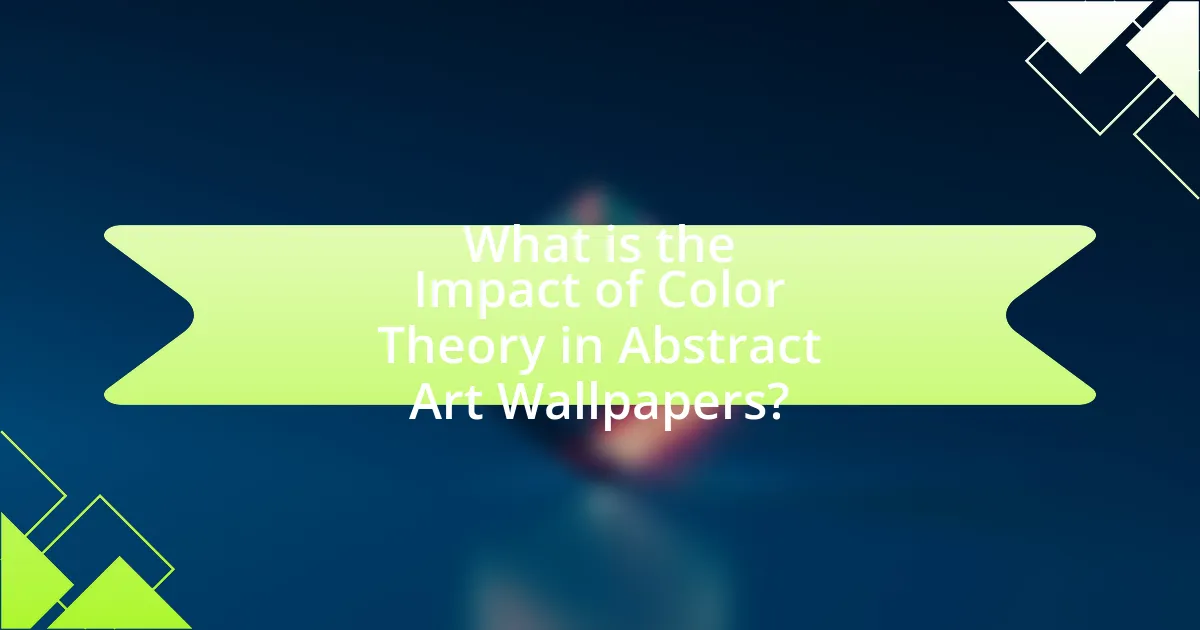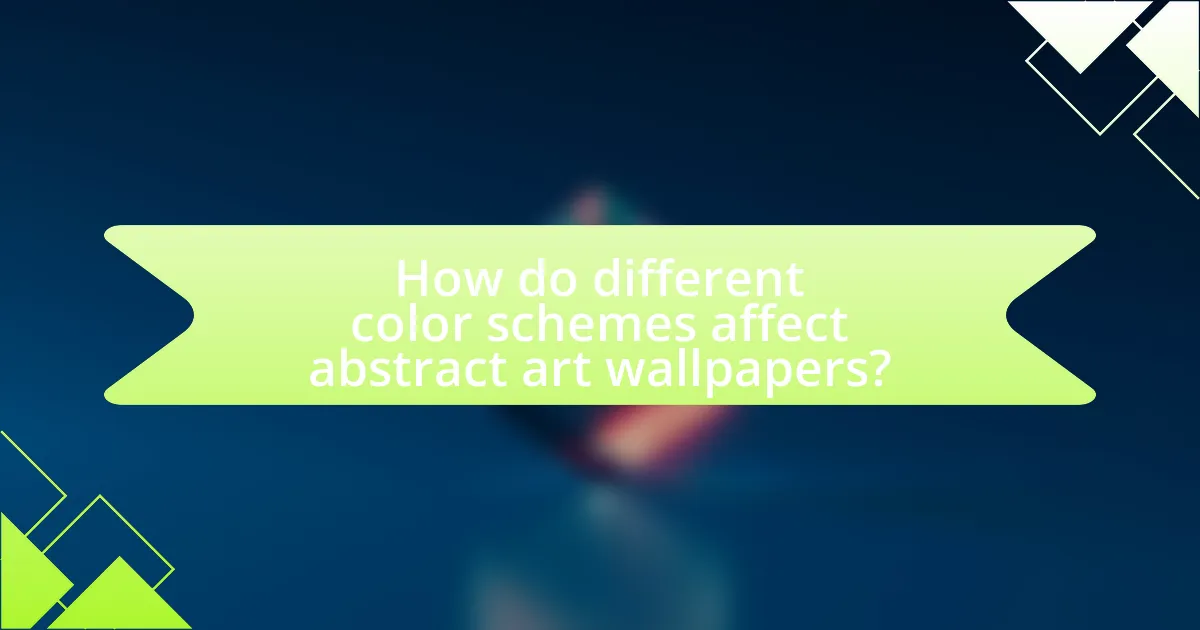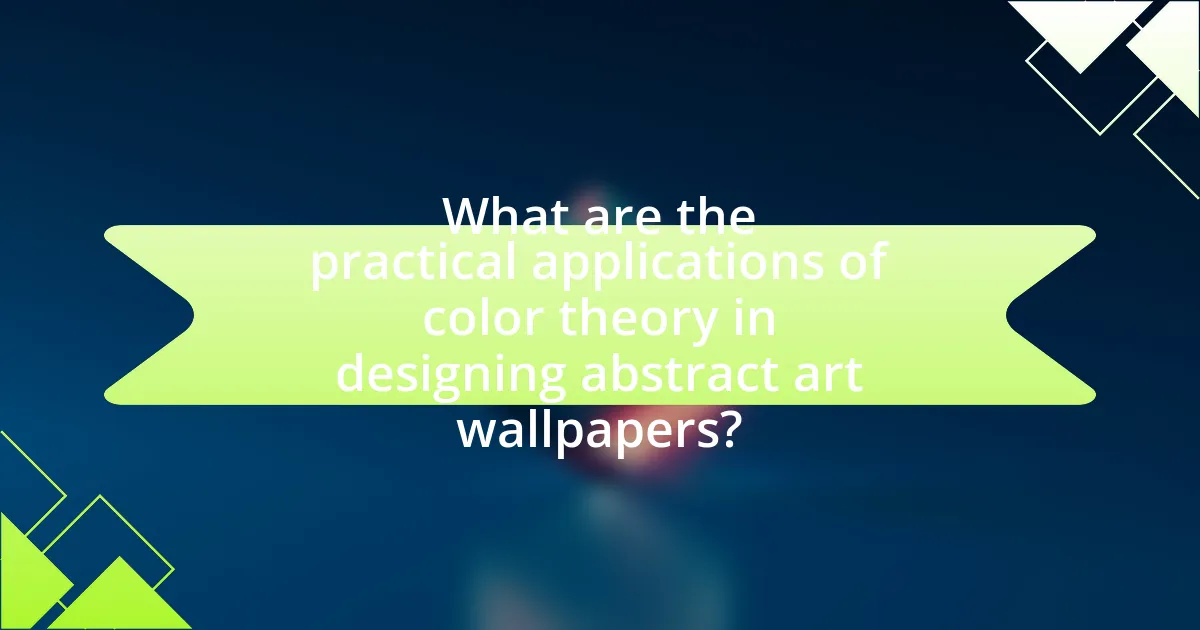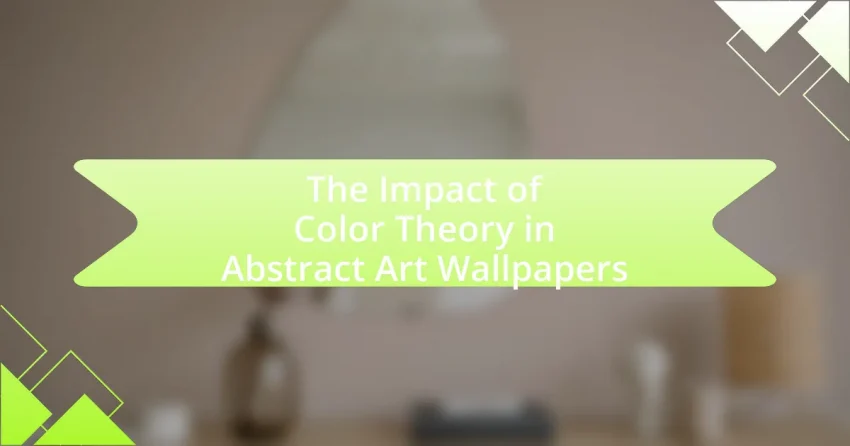The article examines the significant impact of color theory on abstract art wallpapers, highlighting how color combinations influence emotional and psychological responses in viewers. It discusses the fundamental principles of color theory, including color harmony and the psychological effects of colors, and how these principles guide artists in their design choices. Additionally, the article explores various color schemes, such as monochromatic and complementary, and their effects on viewer engagement and emotional responses. Practical applications of color theory in wallpaper design are also addressed, emphasizing the importance of strategic color selection to enhance aesthetic appeal and convey specific themes or messages.

What is the Impact of Color Theory in Abstract Art Wallpapers?
Color theory significantly influences abstract art wallpapers by guiding the emotional and psychological responses of viewers. The use of color combinations can evoke specific feelings; for instance, warm colors like red and orange can create a sense of energy and warmth, while cool colors like blue and green often promote calmness and tranquility. Research indicates that color can affect mood and perception, as demonstrated in studies by the Institute for Color Research, which found that people make judgments about an environment within 90 seconds, primarily based on color. Thus, the strategic application of color theory in abstract art wallpapers not only enhances aesthetic appeal but also shapes viewer experience and emotional engagement.
How does color theory influence the perception of abstract art wallpapers?
Color theory significantly influences the perception of abstract art wallpapers by guiding how colors interact and evoke emotions. The use of complementary colors can create visual tension, while analogous colors promote harmony, affecting viewers’ emotional responses. Research indicates that specific color combinations can elicit distinct psychological effects; for example, warm colors like red and yellow can evoke feelings of warmth and excitement, while cool colors like blue and green can induce calmness and tranquility. This understanding of color relationships allows artists and designers to manipulate viewer perception, enhancing the overall impact of abstract art wallpapers.
What are the fundamental principles of color theory relevant to abstract art?
The fundamental principles of color theory relevant to abstract art include the color wheel, color harmony, and the psychological effects of color. The color wheel organizes hues into a circular format, illustrating relationships between primary, secondary, and tertiary colors, which artists use to create visual interest and balance. Color harmony refers to the pleasing arrangement of colors, often achieved through complementary, analogous, or triadic color schemes, enhancing the aesthetic appeal of abstract compositions. Additionally, the psychological effects of color influence viewer perception and emotional response; for instance, warm colors can evoke energy and passion, while cool colors may convey calmness and tranquility. These principles guide artists in making intentional choices that impact the overall effectiveness of their abstract works.
How do color combinations affect emotional responses in viewers?
Color combinations significantly influence emotional responses in viewers by evoking specific feelings and associations. For instance, warm colors like red and yellow can generate feelings of warmth, excitement, and happiness, while cool colors such as blue and green often evoke calmness and tranquility. Research conducted by the Institute for Color Research indicates that people make a judgment about an environment within 90 seconds of initial viewing, with color being a primary factor in that assessment. Furthermore, studies show that contrasting colors can create tension or excitement, while harmonious color schemes tend to promote feelings of peace and comfort. Thus, the strategic use of color combinations in abstract art wallpapers can effectively manipulate viewer emotions, enhancing the overall impact of the artwork.
Why is color selection crucial in abstract art wallpapers?
Color selection is crucial in abstract art wallpapers because it directly influences emotional response and aesthetic appeal. The choice of colors can evoke specific feelings, such as calmness or excitement, which affects how viewers perceive and interact with the artwork. Research in color psychology indicates that colors can significantly impact mood and behavior; for instance, blue is often associated with tranquility, while red can evoke energy and passion. Therefore, effective color selection in abstract art wallpapers not only enhances visual interest but also shapes the viewer’s emotional experience, making it a fundamental aspect of design in this medium.
What role does color play in creating visual harmony or tension?
Color plays a crucial role in creating visual harmony or tension by influencing emotional responses and compositional balance. In visual harmony, analogous colors, which are adjacent on the color wheel, create a sense of unity and calmness, as seen in artworks that utilize soft blues and greens to evoke tranquility. Conversely, contrasting colors, such as complementary colors located opposite each other on the color wheel, generate visual tension and excitement, exemplified by the use of red and green in abstract art to create dynamic energy. This relationship between color and emotional impact is supported by color theory, which demonstrates that specific color combinations can elicit distinct psychological effects, thereby shaping the viewer’s experience of the artwork.
How can contrasting colors enhance the impact of a wallpaper design?
Contrasting colors enhance the impact of a wallpaper design by creating visual interest and drawing attention to specific elements. This technique leverages the principles of color theory, where complementary colors, such as blue and orange, can intensify each other, making the overall design more dynamic and engaging. Research indicates that high contrast can improve readability and focus, as seen in studies on visual perception, which demonstrate that contrasting colors can lead to better retention of information and emotional responses. Therefore, the strategic use of contrasting colors in wallpaper design not only captivates viewers but also enhances the overall aesthetic and functional qualities of the space.

How do different color schemes affect abstract art wallpapers?
Different color schemes significantly influence the emotional response and aesthetic appeal of abstract art wallpapers. For instance, warm color schemes, such as reds and oranges, tend to evoke feelings of energy and warmth, making spaces feel more inviting. In contrast, cool color schemes, including blues and greens, often create a sense of calm and tranquility, which can enhance relaxation in a room. Research in color psychology supports these effects; studies indicate that colors can impact mood and perception, with specific hues triggering distinct emotional responses. Therefore, the choice of color scheme in abstract art wallpapers is crucial for setting the desired atmosphere in a space.
What are the various color schemes used in abstract art wallpapers?
Various color schemes used in abstract art wallpapers include monochromatic, analogous, complementary, triadic, and tetradic schemes. Monochromatic schemes utilize different shades and tints of a single color, creating a cohesive look. Analogous schemes involve colors that are next to each other on the color wheel, promoting harmony. Complementary schemes use colors opposite each other on the wheel, providing contrast and vibrancy. Triadic schemes consist of three colors evenly spaced around the wheel, offering balance and diversity. Tetradic schemes involve two complementary color pairs, allowing for rich and dynamic compositions. These color schemes are foundational in abstract art, influencing emotional responses and visual impact.
How do monochromatic schemes influence the overall aesthetic?
Monochromatic schemes significantly influence the overall aesthetic by creating a cohesive and harmonious visual experience. These schemes utilize variations in lightness and saturation of a single color, which can evoke specific emotions and set a particular mood. For instance, a monochromatic blue palette can convey calmness and serenity, while a red monochromatic scheme may evoke energy and passion. Research indicates that color can affect psychological responses; for example, studies have shown that blue hues can lower heart rates and promote relaxation, reinforcing the emotional impact of monochromatic designs. Thus, the use of monochromatic color schemes in abstract art wallpapers not only enhances visual unity but also influences viewer perception and emotional engagement.
What effects do complementary colors have on viewer engagement?
Complementary colors significantly enhance viewer engagement by creating visual contrast that captures attention. This contrast stimulates the viewer’s interest and encourages prolonged observation, as the human eye is naturally drawn to the dynamic interplay of opposing colors. Research indicates that artworks utilizing complementary colors can evoke stronger emotional responses, leading to increased viewer interaction and retention. For instance, a study published in the Journal of Experimental Psychology found that artworks with high color contrast, including complementary color schemes, resulted in higher levels of viewer engagement compared to those with analogous colors. This evidence supports the assertion that complementary colors play a crucial role in enhancing viewer engagement in abstract art wallpapers.
How can color schemes convey specific themes or messages?
Color schemes can convey specific themes or messages by utilizing psychological associations linked to different colors. For instance, warm colors like red and orange often evoke feelings of energy and passion, while cool colors such as blue and green are associated with calmness and tranquility. Research indicates that color can influence emotions and perceptions; for example, a study published in the journal “Color Research and Application” by Andrew Elliot and Markus Maier found that red can enhance feelings of excitement, while blue can promote a sense of peace. Therefore, the strategic use of color schemes in abstract art wallpapers can effectively communicate intended themes, such as warmth, serenity, or vibrancy, aligning visual aesthetics with emotional responses.
What themes are commonly represented through warm color palettes?
Warm color palettes commonly represent themes of energy, warmth, and passion. These colors, such as reds, oranges, and yellows, evoke feelings of excitement and enthusiasm, often associated with emotions like love and joy. Research in color psychology indicates that warm colors can stimulate the senses and create a sense of urgency, making them effective in conveying dynamic themes in art and design. For instance, studies show that red can increase heart rates and evoke strong emotional responses, reinforcing its association with passion and intensity.
How do cool colors create a sense of calm or tranquility in designs?
Cool colors, such as blue, green, and purple, create a sense of calm or tranquility in designs by evoking feelings associated with nature and serenity. These colors are often linked to elements like water and sky, which are inherently soothing and promote relaxation. Research indicates that blue can lower heart rates and reduce anxiety, while green is associated with balance and harmony. For instance, a study published in the journal “Color Research and Application” found that participants exposed to cool colors reported lower stress levels compared to those exposed to warm colors. This psychological response to cool colors makes them effective in design contexts where tranquility is desired, such as in abstract art wallpapers.

What are the practical applications of color theory in designing abstract art wallpapers?
Color theory is practically applied in designing abstract art wallpapers by guiding the selection and combination of colors to evoke specific emotions and visual harmony. Designers utilize concepts such as complementary colors to create contrast, analogous colors for cohesion, and triadic schemes for balance, which enhance the aesthetic appeal of wallpapers. For instance, research indicates that warm colors can stimulate energy and excitement, while cool colors promote calmness and relaxation, allowing designers to tailor the mood of a space effectively. Additionally, the use of color psychology informs choices that align with the intended atmosphere of a room, making color theory essential in creating impactful abstract art wallpapers.
How can artists effectively apply color theory in their designs?
Artists can effectively apply color theory in their designs by understanding and utilizing the relationships between colors, such as complementary, analogous, and triadic schemes. By applying these relationships, artists can create visual harmony, contrast, and emotional impact in their work. For instance, complementary colors, which are opposite each other on the color wheel, can enhance each other’s intensity and create dynamic compositions. Research by the Color Association of the United States indicates that color combinations can influence viewer perception and emotional response, demonstrating the importance of strategic color application in design.
What tools and resources are available for color selection?
Color selection tools and resources include color wheels, digital color pickers, and online color palette generators. Color wheels help visualize relationships between colors, while digital color pickers allow users to select and manipulate colors in design software. Online color palette generators, such as Adobe Color and Coolors, provide curated color schemes based on user preferences or existing images. These tools are widely used in design and art to ensure harmonious color combinations, enhancing the visual impact of abstract art wallpapers.
How can artists test color combinations before finalizing designs?
Artists can test color combinations before finalizing designs by utilizing digital tools and physical color swatches. Digital software like Adobe Color or Procreate allows artists to experiment with various palettes and visualize how colors interact in real-time. Additionally, creating physical mock-ups using paint or colored paper helps artists assess the tactile and visual harmony of colors in a tangible format. Research indicates that visual perception of color combinations can significantly influence emotional responses, making these testing methods essential for effective design.
What are some best practices for using color theory in abstract art wallpapers?
Best practices for using color theory in abstract art wallpapers include selecting a cohesive color palette, utilizing color harmony principles, and considering the psychological effects of colors. A cohesive color palette ensures that the colors work well together, enhancing visual appeal and creating a unified look. Utilizing color harmony principles, such as complementary, analogous, or triadic schemes, can create balance and interest in the design. Additionally, understanding the psychological effects of colors—like blue evoking calmness or red stimulating energy—can influence the mood of the space where the wallpaper is applied. These practices are supported by color theory, which emphasizes the importance of color relationships and their impact on perception and emotion.
How can understanding color psychology enhance design choices?
Understanding color psychology can significantly enhance design choices by influencing emotions and perceptions associated with different colors. For instance, research indicates that warm colors like red and yellow can evoke feelings of warmth and excitement, while cool colors such as blue and green are often associated with calmness and tranquility. This knowledge allows designers to strategically select colors that align with the intended message or mood of their artwork, thereby improving viewer engagement and emotional response. Studies, such as those conducted by the Institute for Color Research, demonstrate that people make subconscious judgments about a person, environment, or product within 90 seconds of initial viewing, and up to 90% of that assessment is based on color alone. Thus, leveraging color psychology in design choices can lead to more effective communication and a stronger connection with the audience.
What common mistakes should designers avoid when applying color theory?
Designers should avoid using too many colors in a single design, as this can create visual chaos and dilute the intended message. A common mistake is neglecting color harmony, which can lead to clashing colors that are unpleasant to the eye. Additionally, failing to consider color psychology can result in designs that do not evoke the desired emotional response; for instance, blue often conveys calmness, while red can evoke excitement. Ignoring accessibility, such as color blindness, can alienate a portion of the audience, making it crucial to ensure sufficient contrast and clarity. Lastly, not testing colors in different lighting conditions can lead to unexpected results, as colors can appear differently under various lighting scenarios.
What tips can help in creating impactful abstract art wallpapers using color theory?
To create impactful abstract art wallpapers using color theory, focus on the harmonious use of color combinations that evoke emotions and set the desired mood. Utilizing the color wheel, select complementary colors to create contrast, or analogous colors for a more cohesive look. Research indicates that color can influence perception; for instance, blue often conveys calmness, while red can evoke energy. Additionally, consider the psychological effects of color saturation and brightness, as vibrant colors can attract attention, while muted tones can create a sense of tranquility. By strategically applying these principles, artists can enhance the visual impact of their abstract wallpapers.
